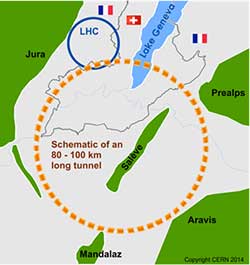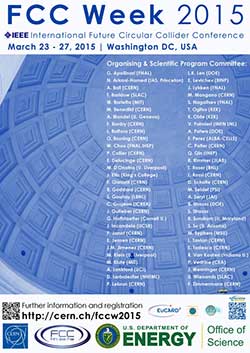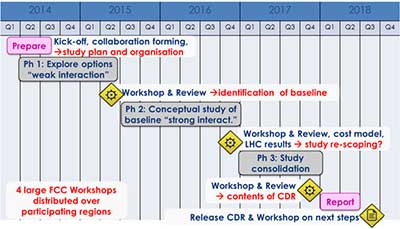Future Circular Collider (FCC) Study
Michael Benedikt and Frank Zimmermann
With the discovery of the Higgs boson by two LHC experiments in 2012, the Standard Model of particle physics has been experimentally validated, concluding almost 80 years of theoretical and experimental efforts. However, the Standard Model is not a complete theory, since several important outstanding questions remain, e.g. the composition of dark matter, the cause of the universe’s accelerated expansion, the origin of the observed matter-antimatter asymmetry, the origin of neutrino masses, the reason for the existence of 3 families of quarks and leptons, the lightness of the Higgs boson, and the weakness of gravity. These questions cannot be explained within the frame of the Standard Model.
Operating at centre-of-mass (c.m.) energies of 7 and 8 TeV in 2011-13, the LHC has not uncovered any evidence yet for physics beyond the standard model. Possibly some new information will be provided by LHC proton-proton collisions at higher c.m. energy (13 and 14 TeV) in 2015-18. How can one go further?
Recognizing that circular proton-proton colliders are the main, and possibly only, experimental tool available in the coming decades for exploring particle physics in the energy range of tens of TeV, the recent update of the European Strategy for Particle Physics, which was adopted by the CERN Council during an exceptional meeting at Brussels in May 2013, requests CERN to “undertake design studies for accelerator projects in a global context with emphasis on proton-proton and electron-positron high-energy frontier machines … [which] should be coupled to a vigorous accelerator R&D programme, including high-field magnets and high-gradient accelerating structures, in collaboration with national institutes, laboratories and universities worldwide” in order to be ready “to propose an ambitious post-LHC accelerator project … by the time of the next Strategy update” [around 2019].

Schematic of a 100-km tunnel for a highest-energy circular collider in the Lake Geneva basin.
In direct response to this European request, at a special FCC kick-off in February 2014 (http://indico.cern.ch/e/fcc-kickoff) CERN has launched the Future Circular Collider (FCC) study (http://cern.ch/fcc), the purpose of which is to deliver a Conceptual Design Report and a cost review by 2018. The focus of the FCC study is a 100-TeV c.m. proton-proton collider (FCC-hh), based on 16-T Nb3Sn magnets in a new 100-km tunnel, with a peak luminosity of 5-10x1034 cm-2 s-1. The FCC-hh defines the infrastructure requirements. The FCC study also comprises the design of a high-luminosity e+e- collider (FCC-ee, formerly TLEP), serving as Z, W, Higgs and top factory, with luminosities ranging from ≈1036 to ≈1034 cm-2 s-1 per collision point at the Z pole and t-tbar threshold, respectively, as a potential intermediate step. In addition, the FCC study considers a proton-lepton (FCC-he) option, with a luminosity of up to 1035 cm-2s-1, reached in collisions of 60-GeV electrons with 50-TeV protons.
Over the last two decades Nb3Sn high-field magnet technology has made great strides forward, thanks to ITER conductor development, US-LARP and EC co-funded R&D activities and the US DOE core development programme. The High-Luminosity upgrade of the LHC (HL-LHC), which is expected to be completed by 2025, includes a few tens of Nb3Sn dipole and quadrupole magnets. The HL-LHC, thereby, prepares the technology base for the FCC-hh. Conceptual cost-optimized designs of FCC 15-20 T high field dipole magnets in block-coil geometry are shown below. The FCC study of a 100-TeV hadron collider can also draw on the results of several pertinent previous studies, including the Italian 300-km ELOISATRON project (ongoing since 1979), a little known but far-sighted “TRISTAN-II” 94-km tunnel infrastructure study in Japan (1983), the ill-fated 87-km SSC project at Waxahachie / Texas (abandoned in 1993), and the ingenious 233-km VLHC design (culminating in the report “Design Study for a Staged Very Large Hadron Collider,”
http://lss.fnal.gov/archive/test-tm/2000/fermilab-tm-2149.pdf
In particular, the VLHC design has greatly advanced the development of cost-effective fast cycling transmission line magnets, and of warm photon stops vis-a-vis an unprecedented synchrotron radiation heat load in the cold arcs.

Conceptual designs of 15- or 16-T (left) and 20-T dipole magnets (right). Only a quarter of one magnet is shown. [E. Todesco, L. Rossi, P. McIntyre].
Aside from the development of high-field magnets, the consequences of synchrotron radiation both for the beam and for the cryo beam vacuum system are among the primary design challenges for the FCC-hh. The key element for FCC-ee is a 100-MW RF system at 400 or 800 MHz, for which advanced cavity production techniques and more efficient RF power sources should be developed.
Ongoing discussions with interested partner institutes are presently being formalized through memoranda of understanding. More than 40 institutes from around the world, in particular from Europe, Asia and North America, have already formally joined the FCC study. In parallel, an international collaboration board with representatives from all study participants has been set up. At the preparatory collaboration-board meeting on 9-10 September 2014, Leonid “Lenny” Rivkin from PSI and EPFL (Switzerland) was unanimously elected as interim Collaboration Board Chair. The first annual FCC workshop held at Washington DC in March 2015, jointly organized by CERN and the US DOE’s Office of Science, marks an important milestone of the FCC study, namely the end of the “weak interaction” phase. The workshop poster of the FCC week and the overall 5-year study time line are shown below.

Workshop poster for the “FCC Week 2015” in Washington DC.

FCC study time line.
Michael Benedikt and Frank Zimmermann are senior scientists at CERN. Benedikt is the FCC Study Leader and Zimmermann Deputy FCC Study Leader. Zimmermann, an APS fellow, also serves as the Editor of the APS journal PRST-AB.
Disclaimer - The articles and opinion pieces found in this issue of the APS Forum on International Physics Newsletter are not peer refereed and represent solely the views of the authors and not necessarily the views of the APS.
